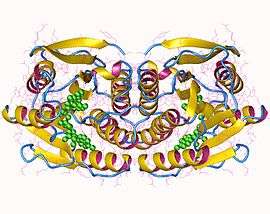6,7-dihydropteridine reductase
In enzymology, a 6,7-dihydropteridine reductase (EC 1.5.1.34, also Dihydrobiopterin reductase) is an enzyme that catalyzes the chemical reaction
- a 5,6,7,8-tetrahydropteridine + NAD(P)+ a 6,7-dihydropteridine + NAD(P)H + H+
| 6,7-dihydropteridine reductase | |||||||||
|---|---|---|---|---|---|---|---|---|---|
 Dihydropteridine reductase dimer, Human | |||||||||
| Identifiers | |||||||||
| EC number | 1.5.1.34 | ||||||||
| CAS number | 9074-11-7 | ||||||||
| Databases | |||||||||
| IntEnz | IntEnz view | ||||||||
| BRENDA | BRENDA entry | ||||||||
| ExPASy | NiceZyme view | ||||||||
| KEGG | KEGG entry | ||||||||
| MetaCyc | metabolic pathway | ||||||||
| PRIAM | profile | ||||||||
| PDB structures | RCSB PDB PDBe PDBsum | ||||||||
| Gene Ontology | AmiGO / QuickGO | ||||||||
| |||||||||
The 3 substrates of this enzyme are a 5,6,7,8-tetrahydropteridine (Tetrahydrobiopterin), NAD+, and NADP+, whereas its 4 products are a 6,7-dihydropteridine (Dihydrobiopterin), NADH, NADPH, and H+. This enzyme participates in folate biosynthesis.
Nomenclature
This enzyme belongs to the family of oxidoreductases, specifically those acting on the CH-NH group of donors with NAD+ or NADP+ as acceptor. The systematic name of this enzyme class is 5,6,7,8-tetrahydropteridine:NAD(P)+ oxidoreductase. Other names in common use include 6,7-dihydropteridine:NAD(P)H oxidoreductase, DHPR, NAD(P)H:6,7-dihydropteridine oxidoreductase, NADH-dihydropteridine reductase, NADPH-dihydropteridine reductase, NADPH-specific dihydropteridine reductase, dihydropteridine (reduced nicotinamide adenine dinucleotide), reductase, dihydropteridine reductase, dihydropteridine reductase (NADH), and 5,6,7,8-tetrahydropteridine:NAD(P)H+ oxidoreductase.
Clinical significance
Dihydropteridine reductase deficiency is a defect in the regeneration of tetrahydrobiopterin. Many patients have significant developmental delays despite therapy, develop brain abnormalities, and are prone to sudden death. The reason is not completely clear, but might be related to the accumulation of dihydrobiopterin and abnormal metabolism of folic acid.[1] Response to treatment is variable and the long-term and functional outcome is unknown. To provide a basis for improving the understanding of the epidemiology, genotype/phenotype correlation and outcome of these diseases their impact on the quality of life of patients, and for evaluating diagnostic and therapeutic strategies a patient registry was established by the noncommercial International Working Group on Neurotransmitter Related Disorders (iNTD).[2] Dihydrobiopterin reductase deficiency is treated with tyrosine supplements, a controlled diet which is lacking in phenylalanine,[3] well as supplementation of L-DOPA.
See also
References
- Longo N (June 2009). "Disorders of biopterin metabolism". Journal of Inherited Metabolic Disease. 32 (3): 333–42. doi:10.1007/s10545-009-1067-2. PMID 19234759.
- "Patient registry".
- Pawlina, Wojciech; Ross, Michael W. (2006). Histology: a text and atlas: with correlated cell and molecular biology. Philadelphia: Lippincott Wiliams & Wilkins. ISBN 0-7817-5056-3.
Further reading
- Harano T (1972). "New diaphorases from Bombyx silkworm eggs. NADH/NADPH cytochrome c reductase activity mediated with 6,7-dimethyltetrahydropterin". Insect Biochem. 2 (8): 385–399. doi:10.1016/0020-1790(72)90019-4.
- Hasegawa H (January 1977). "Dihydropteridine reductase from bovine liver. Purification, crystallization, and isolation of a binary complex with NADH". Journal of Biochemistry. 81 (1): 169–77. PMID 191436.
- Kaufman S (1962). "Phenylalanine hydroxylase". Methods Enzymol. 5: 809–816. doi:10.1016/s0076-6879(62)05317-3.
- Lind KE (February 1972). "Dihydropteridine reductase. Investigation of the specificity for quinoid dihydropteridine and the inhibition by 2,4-diaminopteridines". European Journal of Biochemistry / FEBS. 25 (3): 560–2. doi:10.1111/j.1432-1033.1972.tb01728.x. PMID 4402916.
- Nakanishi N, Hasegawa H, Watabe S (March 1977). "A new enzyme, NADPH-dihydropteridine reductase in bovine liver". Journal of Biochemistry. 81 (3): 681–5. PMID 16875.